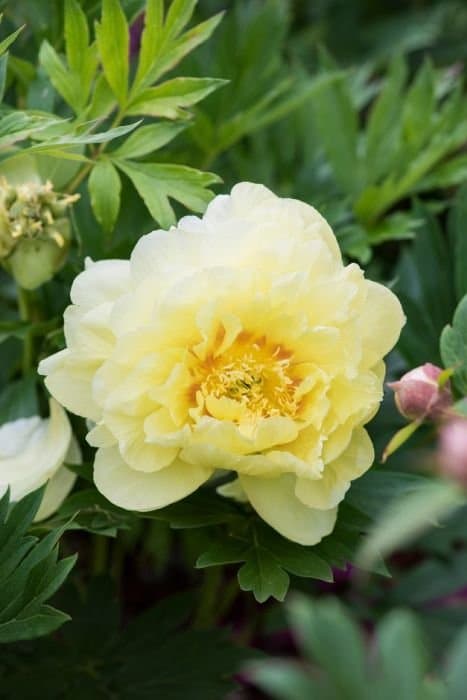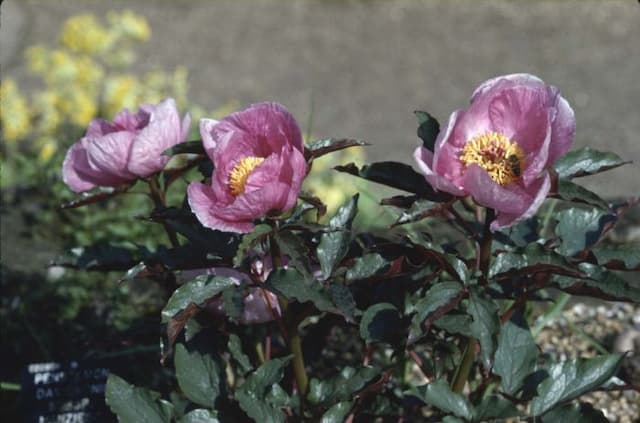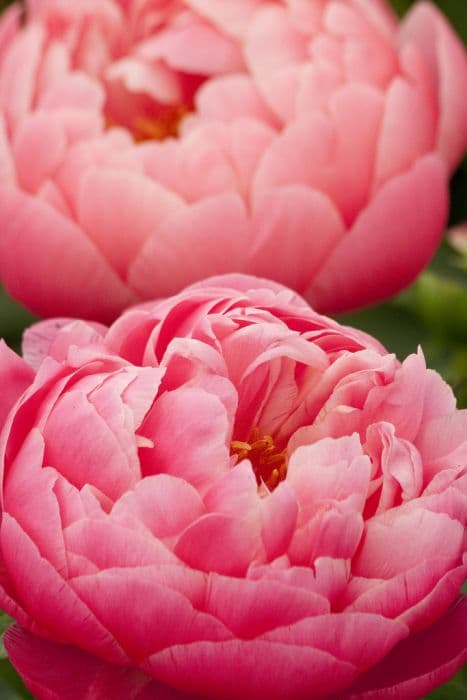Chinese Peony Paeonia lactiflora 'White Wings'

ABOUT
The plant known as the 'White Wings' peony features a lush display of large, bowl-shaped flowers that are pure white in appearance, resembling the softness and grace of delicate white wings. The petals are silky, broad, and often gently curved, converging to form a full, rounded bloom that captures the essence of classical floral beauty. At the center of each flower, a cluster of golden-yellow stamens creates a striking contrast, adding depth and a touch of warmth to the cool white petals. The leaves of the 'White Wings' peony are a deep green, providing a rich backdrop that accentuates the purity of the blossoms. The foliage is divided into leaflets that are compound, with an elegant shape that complements the overall aesthetic of the plant. This peony is renowned for its sweet, subtle fragrance that emanates from the blooms, adding to its allure and making it a prized choice for gardens and floral arrangements.
About this plant
 Names
NamesFamily
Paeoniaceae
Synonyms
White Wings Peony, Chinese Peony, Common Garden Peony
Common names
Paeonia lactiflora 'White Wings'.
 Toxicity
ToxicityTo humans
The common name of Paeonia lactiflora 'White Wings' is peony. Peonies are generally considered non-toxic to humans. However, some people may have sensitivity or allergic reactions to peony, which can result in skin irritation or an upset stomach if ingested. They are not known to be seriously poisonous, and severe consequences are rare, but it is still advisable not to consume this plant.
To pets
Peony, the common name for Paeonia lactiflora 'White Wings', is mildly toxic to pets such as dogs and cats. If ingested, they may experience symptoms such as vomiting, diarrhea, or possible skin irritation. While peonies are not known for causing severe poisoning, they can still create discomfort and health issues for pets, so it is best to prevent them from eating any part of the plant.
 Characteristics
CharacteristicsLife cycle
Perennials
Foliage type
Deciduous
Color of leaves
Green
Flower color
White
Height
2-3 feet (60-90 cm)
Spread
2-3 feet (60-90 cm)
Plant type
Herb
Hardiness zones
3-8
Native area
China
Benefits
 General Benefits
General Benefits- Ornamental Value: The Paeonia lactiflora 'White Wings', commonly known as the Chinese peony, has large, fragrant, white blooms that add aesthetic appeal to gardens.
- Pollinator Attraction: It attracts bees and butterflies, which are important for pollination and maintaining healthy ecosystems.
- Cut Flower Use: The flowers are long-lasting when cut and make exquisite arrangements, enhancing indoor decor.
- Seasonal Interest: Provides a dramatic display in spring when in full bloom, creating seasonal interest in garden landscapes.
- Drought Tolerance: Once established, it has a degree of drought tolerance, reducing the need for frequent watering.
- Perennial Growth: As a perennial, it regrows each year from the same roots, offering a long-term addition to gardens.
- Ease of Care: The plant generally requires minimal maintenance aside from some pruning and winter protection in colder zones.
 Medical Properties
Medical Properties- Anti-inflammatory: Components of Paeonia lactiflora may help reduce inflammation in the body.
- Analgesic: It might be used to alleviate pain in traditional practices.
- Immunomodulatory: The root extract is believed to have effects on the immune system.
- Antispasmodic: Peony is traditionally used to relieve muscle spasms.
- Neuroprotective: There is some evidence suggesting neuroprotective effects.
- Antioxidant: Contains antioxidants that help in protecting cells from damage caused by free radicals.
- Hepatoprotective: May offer some protection to the liver from certain toxins.
 Air-purifying Qualities
Air-purifying QualitiesThis plant is not specifically known for air purifying qualities.
 Other Uses
Other Uses- Artistic Inspiration: The white peony's exceptional beauty has often inspired artists and photographers, who use it as a subject in paintings, drawings, and photographic art.
- Culinary Garnish: The petals of white peony are edible and can be used to add elegance to salads or as a decorative garnish for high-end culinary presentations.
- Aromatherapy: White peony possesses a subtle, pleasing fragrance, which can be incorporated into potpourris and sachets for a natural and gentle aromatherapy experience.
- Wedding Decor: Due to their association with happiness and prosperity, white peonies are often used in bridal bouquets and as decor for weddings and ceremonial events.
- Dyeing Fabric: The petals of white peony can be used to create a natural, light pink dye for fabrics, offering a sustainable alternative to synthetic dyes.
- Floral Crafts: Dried white peony flowers can be used in crafting, such as in making floral arrangements, wreaths, and other decorative items.
- Personal Care Products: The essence of white peony is sometimes used in the manufacture of perfumes, lotions, and other personal care products due to its fragrance.
- Garden Design: White peonies are utilized by landscape designers to create monochromatic or white-themed garden spaces that showcase serenity and simplicity.
- Educational Tool: Botany and horticulture students study white peony for its complex reproductive system and cultivation requirements, gaining practical gardening knowledge.
- Cultural Symbolism: In some cultures, the white peony is considered a symbol of good fortune and is used in various cultural ceremonies and traditions.
Interesting Facts
 Feng Shui
Feng ShuiThe Peony is not used in Feng Shui practice.
 Zodiac Sign Compitability
Zodiac Sign CompitabilityThe Peony is not used in astrology practice.
 Plant Symbolism
Plant Symbolism- Prosperity: Peonies like the 'White Wings' variety often symbolize wealth and good fortune, making them a popular choice for celebrations that wish financial success.
- Honor and Nobility: In many cultures, peonies are associated with honor and high social status due to their lush and grand appearance.
- Romance and Marital Bliss: The full, rounded blooms of peonies, including 'White Wings', represent love and affection, and are believed to bring happiness to marriages.
- Compassion: The soft, delicate petals of the 'White Wings' peony can evoke a sense of compassion and care, often being used to convey sympathy.
- Beauty in all Forms: With its stunning white flowers, 'White Wings' peony is a symbol of beauty, often reflecting the idea of inner and outer beauty.
 Water
WaterPeonies, including the 'White Wings' variety, should be watered deeply about once a week during their growing season, especially if the weather is particularly dry. In terms of the amount, aim for about 1 inch of water which translates to roughly 0.5 to 0.6 gallons per square yard of soil. Always water at the base of the plant to avoid wetting the foliage, which can lead to fungal diseases. During the fall and winter, reduce watering as the plant goes dormant. Overwatering can cause root rot, so it's important to ensure the soil drains well and does not stay waterlogged.
 Light
LightPeonies like 'White Wings' thrive in an environment where they can receive full sun for at least 6 to 8 hours a day. The best spot for them would be in a garden area with clear exposure to sunlight without significant shade from trees or buildings. If full sun isn't possible, a location with dappled light or partial shade, particularly in the afternoon, is the next best option.
 Temperature
Temperature'White Wings' Peonies are hardy and can tolerate a wide temperature range but perform best in regions with cold winters and warm summers. They can survive winter temperatures as low as -20°F and prefer a growing season with temperatures ranging between 65°F and 75°F. It's crucial to have a cold period of at least 30 to 40 days with temperatures below 40°F to ensure proper dormancy and future flowering.
 Pruning
PruningPeonies, such as the 'White Wings', should be pruned to remove spent flowers after blooming to maintain a tidy appearance and encourage future blooms. In late fall, after first frost, cut back the foliage to about 3 inches above ground level to prepare the plant for winter and help prevent disease. Pruning is also the time to remove any damaged or diseased stems to promote healthy growth. Peonies generally do not require extensive pruning, and it’s best done on an as-needed basis.
 Cleaning
CleaningAs needed
 Soil
SoilThe best soil mix for Peony 'White Wings' is well-draining, fertile loam with a pH of 6.5 to 7.0. A blend of two-thirds garden soil and one-third compost or well-rotted manure is ideal to provide the necessary nutrients and drainage.
 Repotting
RepottingPeonies, including the 'White Wings' variety, are not typically grown in containers and hence, do not require repotting. They are perennial plants that thrive when planted in the ground and can remain in the same location for many years.
 Humidity & Misting
Humidity & MistingPeony 'White Wings' is tolerant of typical outdoor humidity levels and does not require specific humidity conditions. It is more important to focus on proper planting and soil moisture for this plant than on environmental humidity.
 Suitable locations
Suitable locationsIndoor
Peonies like 'White Wings' are ill-suited for indoor growing, prefer garden.
Outdoor
Plant in rich soil, full sun; divide every few years.
Hardiness zone
3-8 USDA
 Life cycle
Life cyclePaeonia lactiflora 'White Wings', commonly known as the Chinese peony 'White Wings', starts its life as a dormant tuber, which breaks dormancy in early spring when shoots emerge from the soil. The shoots grow into stems adorned with dark green, deeply lobed leaves, forming a bushy, herbaceous perennial. During late spring to early summer, 'White Wings' blossoms, producing large white flowers with a central tuft of golden-yellow stamens. After flowering, the plant sets seeds in the form of follicles that, when mature, split open to disperse seeds. In autumn, the foliage of 'White Wings' turns a golden color before dying back as the plant enters dormancy, retracting energy back into the tuber for winter. With the arrival of the next spring, the cycle begins anew as the plant reemerges, grows, and continues to flower annually.
 Propogation
PropogationPropogation time
Early Spring
Propogation: The Paeonia lactiflora 'White Wings', commonly known as the White Peony, is typically propagated through division, which is the most popular method for this plant. Propagation by division is best done in the fall, after the plant has become dormant. To propagate by division, carefully dig up an established peony clump and gently shake off the excess soil. Using a sharp knife or garden spade, divide the clump into sections, making sure each section has at least 3 to 5 buds, commonly referred to as "eyes", and a good amount of roots. Replant the divisions immediately, positioning the eyes about 1.5 to 2 inches deep (3.8 to 5 cm) in well-drained, fertile soil in a location that receives full sun to light shade. Water the newly planted divisions thoroughly to settle the soil around the roots, taking care to avoid wetting the foliage which can lead to fungal diseases. With proper care, these divisions will develop into flowering plants over the next few years.









